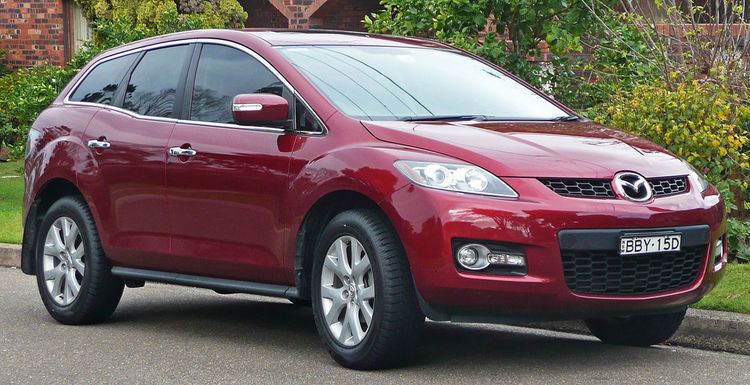Class Mid-size crossover SUV | Designer Koizumi Iwao (2003) Body style 4-door SUV | |
 | ||
Production February 20, 2006–August 20, 2012 | ||
The Mazda CX-7 is a mid-size crossover SUV model from Mazda, and is the production version of the MX-Crossport concept car. The CX-7 was shown publicly for the first time at the 2006 Los Angeles Auto Show in January. Production officially began on February 20 at Mazda's Ujina#2 factory in Hiroshima. The CX-7 went on sale in spring 2006 as a 2007 model and was discontinued in 2012 in favor of the new Mazda CX-5. It is also Mazda's first mid-size SUV since the Navajo was discontinued in 1994.
Contents
- Engine and transmission
- Model range prices and features
- 2010 update
- Offroad Capabilities
- Engine
- Name origin
- Possible revival
- References
Though outwardly similar, the CX-7 and the Mazda CX-9 do not share platforms. The CX-7 shares the front suspension of the Mazda MPV minivan and the rear suspension from the Mazda5. It shares its turbocharged inline-4 engine with the Mazdaspeed6 and uses a 6-speed automatic transmission.
Sales of the CX-7 were mediocre, as it slotted between the sizes of compact and midsize crossovers, so it was not competitive in either category, plus the turbocharged model had poor fuel economy. The 2012 model year was the last year for the CX-7 to make way for the release of the CX-5. The CX-5 has a more efficient powertrain and more interior room, while its exterior is smaller than the CX-7.
Engine and transmission
Power comes from the same 2.3 L straight-4 MZR engine used in the Mazdaspeed3 and Mazdaspeed6 coupled with a 6-speed Aisin automatic transmission, and tuned to produce 244 hp or 182 kW (Australian model 175 kW) at 5000 rpm and 258 lb·ft (350 N·m) of torque at a low 2500 rpm, 99% of the maximum torque is available to 5000 rpm.
The MZR 2.3L DISI turbo engine found in the Mazdaspeed3 and Mazdaspeed6 has been retuned in the North American-Spec CX-7 to deliver torque at a lower rpm for less turbo lag off the line, at the cost of power. This was achieved thanks to a redesigned, smaller K04 turbocharger. UK-Spec CX-7's feature the same, larger K04 turbocharger and transmission found in the Mazdaspeed line.
Model range, prices and features
The CX-7 features fully independent suspension, four-wheel ventilated disc brakes with standard anti-lock brakes, stability control and traction control, and a choice of either front-wheel drive or Mazda's Active Torque-Split all-wheel-drive system. With the Active Torque-Split system, two computer-controlled magnetic clutches feed up to 50% of the engine's torque to the rear wheels. The Australian combined cycle official fuel economy is 11.5 L/100 km (25 mpg‑imp; 20.5 mpg‑US), similar to the Holden Captiva. But real-world fuel economy is nearer to 18.0 L/100 km (15.7 mpg‑imp; 13.1 mpg‑US), as much or more than the Ford Territory.
As of the 2010 model, there are four trim levels (model):
Canadian models:
Australian models (AWD only):
UK models (AWD only), not offered at the same time
2010 update
This is an update to the original. The exterior design features revised front and rear fascias with the front adopting the larger five-point grille design similar in appearance to the recently redesigned RX-8, MX-5 and Mazda3/Axela. The new interior features redesigned gauges with blackout meters that feature three-dimensional dials, a 3.5 inch super-twisted nematic (STN) monochrome and 4.1-inch thin-film transistor (TFT) colour Multi Information Display (MID), (positioned at the top of the instrument panel), Bluetooth compatibility, and a Blind Spot Monitoring System.
The car was unveiled at the 2009 Canadian International Auto Show.
The diesel version now includes a manual transmission, and has been on sale in Europe since 2009.
Offroad Capabilities
While officially classed as a 'Mid-size crossover SUV', the Mazda CX-7 is considered as a 'Soft-Roader' by automotive sources. The CX-7 features an active torque-split four wheel drive system which sends up to 50% of the torque to the rear wheels on a slippery surface to ensure a consistency of grip.
Engine
Engine choices include 2.5-litre MZR 4-cylinder engine that produces 161 hp (120 kW) and 161 lb·ft (218 N·m) of torque and the same MZR 2.3L DISI Turbo engine from before. Transmission is a 5-speed automatic for the 2.5 and a 6-speed automatic for the 2.3 DISI Turbo engine.
Name origin
The CX-7 reminds one of the name RX-7, (which was a sports car that was discontinued and replaced by RX-8), but the first letter, 'R' ('R' means rotary engine), was changed to 'C' ('C' means crossover SUV).
Possible revival
Although not yet officially confirmed, the CX-7 nameplate could be used on an all-new seven-seater based on a stretched Mazda CX-5, due to the growing popularity of three-row crossovers. The potential new CX-7 is set to debut sometime next year.
